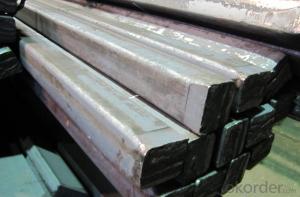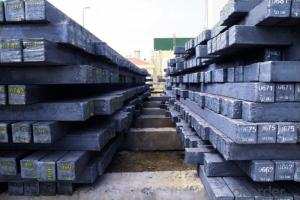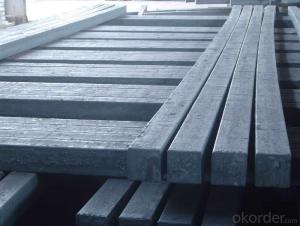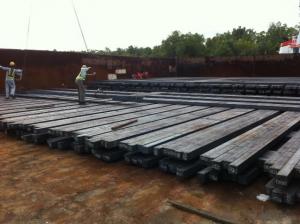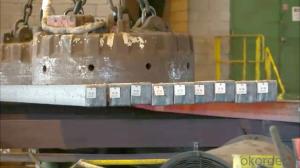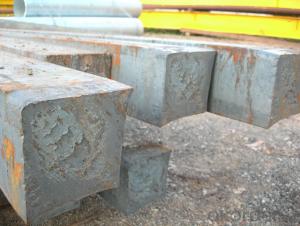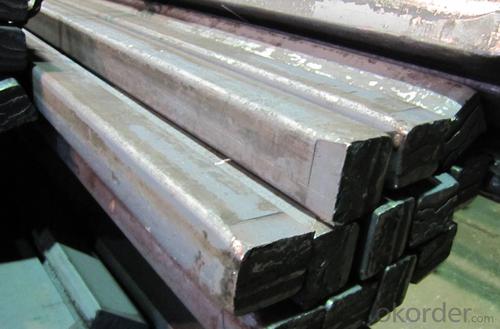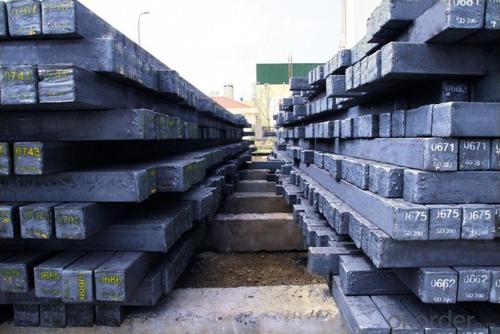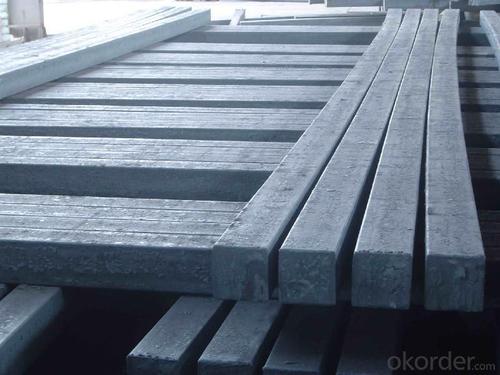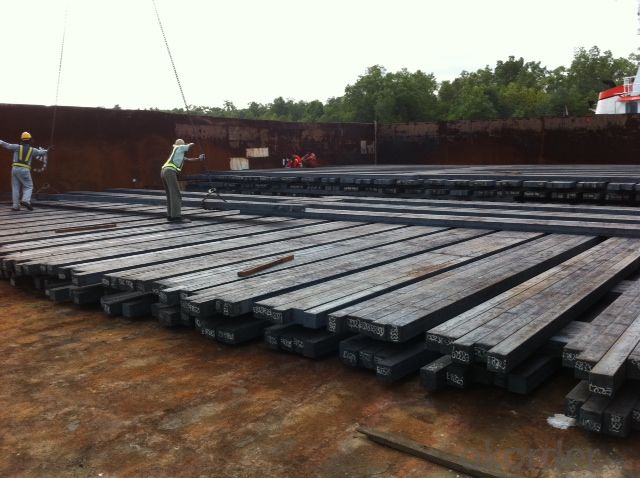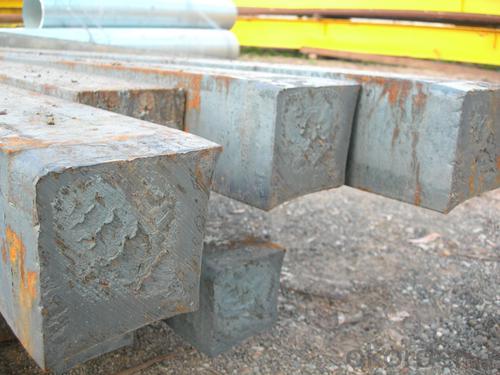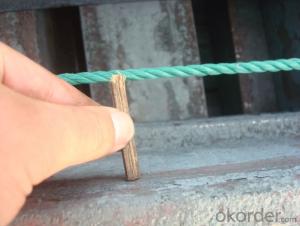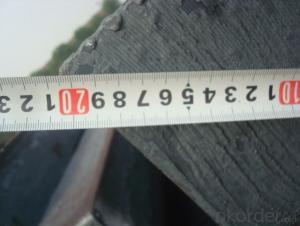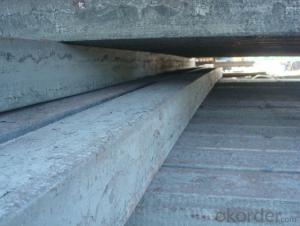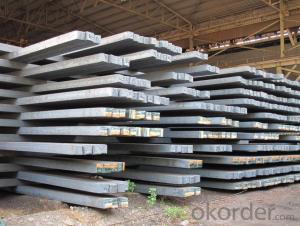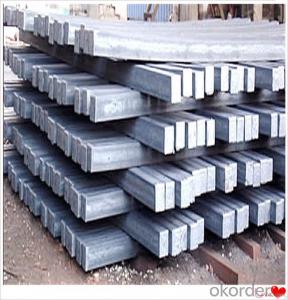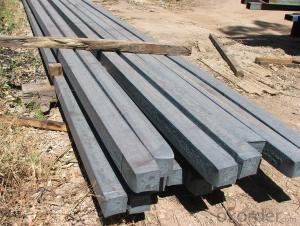Prime Q275 160mm Square Alloy Steel Billet
- Loading Port:
- Shanghai
- Payment Terms:
- TT OR LC
- Min Order Qty:
- 100 m.t.
- Supply Capability:
- 10000 m.t./month
OKorder Service Pledge
OKorder Financial Service
You Might Also Like
Structure of Prime Q275 160mm Square Alloy Steel Billet
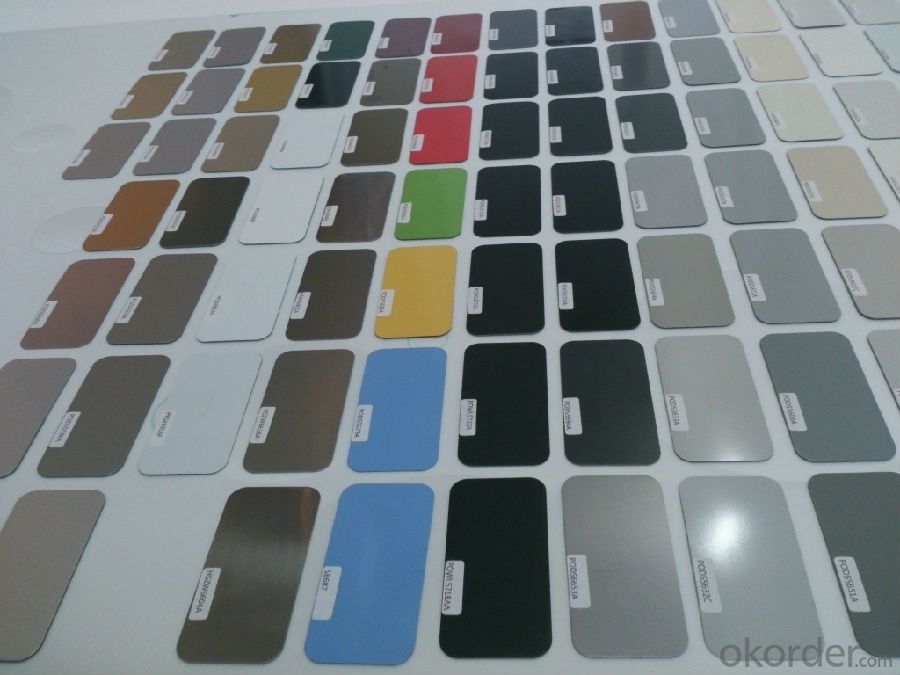
Description of Prime Q275 160mm Square Alloy Steel Billet
1. Prepainted steel coil is coated with organic layer, which provides higher anti-corrosion property and a longer lifespan than that of galvanized or galvalume steel sheets.
2. The base metals for prepainted steel coil consist of cold rolled, HDGI Steel, electro-galvanized and hot-dip alu-zinc coated steel. The finish coats of prepainted steel coil can be classified into groups as follows: polyester, silicon modified polyesters, polyvinylidene fluoride, high-durability polyester, etc.
3. The production process has evolved from one-coating-and-one-baking to double-coating-and-double-baking, and even three-coating-and-three-baking.
4. The color of the prepainted steel coil has a very wide selection, like orange, cream-colored, dark sky blue, sea blue, bright red, brick red, ivory white, porcelain blue, etc.
5. The prepainted steel coils can also be classified into groups by their surface textures, namely regular prepainted sheets, embossed sheets and printed sheets.

Main Feature of Prime Q275 160mm Square Alloy Steel Billet
They were one of several reasons for the wind to be taken out of the sails of the recent oil price momentum. Kuwait’s oil minister said that his country would only commit to a production freeze if all major producers are involved, including Iran. We also had Goldman telling us that oil markets will not rebalance at $40/bbl as it throws a lifeline to cash-strapped US producers.
If it is talk of a production freeze that is behind the rally it shows how low expectations have fallen. It is in the nature of oil people to talk the market up. Any bullish crumb is given exaggerated significance and any port in a storm will do. It is all but fact that the oil market will be tighter in the second half of this year when seasonal demand shoots up and US production continues to decline. It was the same picture last year. If OPEC and key non-OPEC production is frozen that will ensure the daily surplus will fall, but in all likelihood there will still be a surplus and there is an enormous global stockbuild to burn off.
Applications of Prime Q275 160mm Square Alloy Steel Billet
A. Corrugated design makes it excellent waterproof performance
B. Materials as prepainted steel sheets, galvanized steel sheets, galvalume (Al-Zn coated sheets) are available to make corrugated sheet.
C.Those material are durable, anti-corrosion in bad weather for 20-30 years based on it's Zinc(Galvanized) coating or AZ (Galvalume) coating.
D. Different shape of the sheet make it suitable for any style of buildings.
E.Easy to install, no need special tools to fix the sheet.
F.Light weight due to high strength to weight ratio of steel. Light weight means easier handling lower shipping costs, easier installation
G. Different color is availbe base on the RAL Standard make your building more beautiful.
H. We will provide the best solutions if you don't have a exact idea of the specification you want for the steel sheet based on your weather conditions, engineering structure, construction budget and so on.

Specifications of Prime Q275 160mm Square Alloy Steel Billet
Product | Billet |
Material Grade | SGCC / SGCH / DX51D+AZ, etc |
Thickness | 0.6-3.0mm |
Width | 500-1500mm |
Tolerance | Thickness: +/-0.02mm , Width:+/-2mm |
Zinc-coating | Z30-150g/m2 |
Technique | Raw material: Hot rolled steel coil --> Cold rolled_>hot dipped galvalume |
Surface | Dried, Chromated, Unoiled |
Spangle | Regular spangle , small spangle, zero spangle |
ID | 508MM 610MM |
Coil weight | 1-25MT |
Export package | Cardboard inner sleeves, Waterproof paper, galvanized steel covered and steel strip packed |
FAQ of Prime Q275 160mm Square Alloy Steel Billet
We have organized several common questions for our clients,may help you sincerely:
1. How Can I Visit There?
Our company is located in Tianjin City, China, near Beijing. You can fly to Tianjin Airport Directly. All our clients, from home or aboard, are warmly welcome to visit us!
2. How Can I Get Some Sample?
Poor trade figures from China punctured commodity optimism yesterday although they came with warnings that perhaps the numbers were distorted by Chinese New Year celebrations and we will have to wait for the March figures to gain a true picture of the state of China’s landing. Exports for February were -25.4% and imports -13.8% year-on-year.
- Q: What are the main steel billet producing countries?
- The main steel billet producing countries are China, India, Russia, Japan, and the United States. China is the largest producer of steel billets, accounting for approximately half of the global production. This is followed by India, which has also emerged as a major player in the steel industry. Russia, known for its vast reserves of iron ore and coal, is another significant producer of steel billets. Japan, a highly industrialized nation, has a well-established steel industry and contributes significantly to the global production. Lastly, the United States, with its advanced technology and large steel mills, also plays a significant role in steel billet production. These countries not only produce steel billets for domestic consumption but also export to meet the global demand for steel products.
- Q: How are steel billets manipulated during the manufacturing process?
- Steel billets are manipulated during the manufacturing process through various methods such as heating, rolling, forging, and cutting. Heating the billets makes them more malleable and easier to shape. Rolling involves passing the heated billets through a series of rollers to reduce their thickness and create desired shapes. Forging is another technique where the billets are shaped using compressive forces. Finally, cutting is done to obtain specific lengths or shapes required for further processing or fabrication.
- Q: What are the different methods of steel billet surface inspection?
- In the industry, various methods are commonly employed for inspecting the surface of steel billets. These techniques aim to identify any flaws or imperfections, guaranteeing the use of high-quality steel in the manufacturing process. 1. Visual inspection: Trained inspectors visually examine the billet's surface for visible defects like cracks, dents, scratches, or irregularities. While a straightforward approach, it serves as a crucial initial step in the inspection process. 2. Magnetic particle inspection: This method involves applying a magnetic field to the billet's surface and then introducing iron particles suspended in liquid. If there are any surface defects or cracks, the iron particles adhere to them, creating a visible indication. This technique is especially effective for detecting surface cracks. 3. Eddy current testing: Employing electromagnetic induction, this method detects surface defects. A probe is passed over the billet's surface, and any changes in electrical conductivity caused by cracks or defects generate eddy currents, which can be identified and analyzed. It is commonly used for detecting surface cracks, but it can also measure coating thickness or identify material property variations. 4. Ultrasonic testing: Ultrasonic waves are utilized to inspect the billet's surface for defects. A transducer sends ultrasonic waves into the material, and any changes in the wave pattern caused by surface defects are detected and analyzed. This method is frequently employed for detecting surface cracks, but it also provides insight into the internal structure of the billet. 5. Dye penetrant inspection: This method involves applying colored dye to the billet's surface, which is then removed, leaving the dye trapped within any defects or cracks. A developer is then applied to enhance the visibility of the dye, facilitating the identification and localization of surface defects. It is particularly effective for detecting small surface cracks. 6. Laser scanning: Laser scanning employs a laser beam to scan the billet's surface and generate a three-dimensional representation. This method is valuable for detecting surface irregularities, measuring dimensions, and creating digital models for further analysis. Each of these methods possesses unique advantages and limitations, often employed in combination to ensure a comprehensive inspection of the steel billet's surface. The choice of inspection method depends on factors such as the targeted defects, billet size and shape, and desired level of accuracy.
- Q: What are the different methods of steel billet surface polishing?
- There are several methods of steel billet surface polishing, including mechanical polishing, chemical polishing, electropolishing, and abrasive blasting. Mechanical polishing involves using abrasive materials and machinery to remove surface imperfections and create a smooth finish. Chemical polishing utilizes chemical solutions to dissolve and remove surface impurities, resulting in a polished surface. Electropolishing involves the use of an electric current to dissolve and remove surface material, resulting in a smooth and shiny finish. Abrasive blasting uses high-pressure air or water to propel abrasive particles onto the surface, removing contaminants and creating a polished appearance.
- Q: How are steel billets used in the production of transmission components?
- Steel billets are an essential raw material used in the production of transmission components. These billets are semi-finished products that are typically obtained through the casting process. They are usually rectangular or square in shape and have a cross-sectional area that is larger than the final product. The production of transmission components involves shaping the steel billets into the desired forms. This is done through a series of processes like forging, rolling, or extrusion. Each of these processes is aimed at transforming the steel billets into specific shapes and sizes required for transmission components such as gears, shafts, bearings, and housings. Forging is a common method used to shape the steel billets. It involves applying heat to the billet and then using mechanical force to deform it into the desired shape. This process enhances the strength and durability of the transmission components. Rolling is another method used in the production of transmission components. In this process, the steel billets are passed through a series of rollers that gradually reduce their cross-sectional area. This helps to achieve the desired shape and dimensions of the components. Extrusion is also employed in certain cases, especially for producing complex shapes. In this process, the steel billets are forced through a die to obtain the desired form. This allows for the production of intricate transmission components such as splined shafts or valves. Once the steel billets have been shaped into the required forms, they undergo further machining processes like cutting, drilling, and grinding to achieve the final specifications. These components are then heat-treated and coated to enhance their strength, durability, and resistance to corrosion. Overall, steel billets play a crucial role in the production of transmission components by providing a versatile and reliable raw material that can be shaped into various forms. They ensure the transmission components possess the necessary strength, durability, and precision required for efficient and reliable operation in vehicles and machinery.
- Q: How is the quality of steel billets ensured during the manufacturing process?
- The quality of steel billets is ensured during the manufacturing process through various measures such as rigorous inspection and testing procedures. These include visual inspections, dimensional checks, and non-destructive testing techniques like ultrasonic testing or magnetic particle inspection. Additionally, chemical analysis is conducted to verify the composition of the steel billets, ensuring they meet the required specifications. By implementing these quality control measures, any potential defects or inconsistencies can be identified and addressed promptly, ensuring the production of high-quality steel billets.
- Q: What is the melting point of steel billets?
- The melting point of steel billets can vary depending on the type of steel being used. Generally, the melting point of steel ranges from 1370 to 1530 degrees Celsius (2500 to 2800 degrees Fahrenheit). However, it is important to note that different grades and compositions of steel can have slightly different melting points. Additionally, the melting point can also be influenced by other factors such as impurities, alloying elements, and the presence of other metals in the steel. Therefore, it is always recommended to refer to the specific material specifications or consult with metallurgical experts for precise information on the melting point of steel billets.
- Q: How are steel billets tested for mechanical properties?
- Steel billets are tested for mechanical properties through various methods such as tensile testing, hardness testing, and impact testing. Tensile testing involves subjecting the billets to tension until they fracture, measuring their strength and ductility. Hardness testing determines the billets' resistance to indentation or penetration, indicating their overall strength. Impact testing assesses the billets' ability to absorb energy by subjecting them to a sudden load, measuring their toughness. These tests ensure that the steel billets meet the required mechanical properties for their intended applications.
- Q: How are steel billets inspected before they are used in production?
- Steel billets are inspected before they are used in production through a rigorous quality control process. This typically includes visual inspection to check for surface defects and dimensional accuracy. Additionally, non-destructive testing techniques such as ultrasonic testing or magnetic particle inspection are employed to detect internal flaws or cracks. Chemical analysis is performed to ensure the steel composition meets the required specifications. These inspections help ensure the integrity and quality of the billets before they are used in production.
- Q: How do steel billets contribute to the overall vibration resistance of a structure?
- The specific characteristics of steel billets make a significant contribution to the overall vibration resistance of a structure. Primarily, steel is a dense and rigid material, giving it a high natural frequency. This allows steel billets to effectively absorb and dissipate energy from external vibrations, surpassing the capabilities of other materials. Additionally, steel billets exhibit exceptional damping properties. Damping refers to a material's ability to diminish the magnitude of vibrations over time. Due to their density and rigidity, steel billets can rapidly absorb and dissipate vibrations, thus preventing their spread throughout the structure. This aids in reducing overall vibration levels and subsequently enhances the structure's resistance to vibrations. Furthermore, steel billets possess remarkable tensile strength and stiffness, enabling them to withstand deformation caused by dynamic loads. Consequently, when subjected to vibration forces, steel billets retain their shape and structural integrity, minimizing the risk of failure or damage. The high tensile strength of steel also allows it to endure external forces without enduring substantial deformation or permanent harm. Moreover, steel billets can be specifically designed and manufactured to precise dimensions and shapes, facilitating their optimal integration into various structural components. This ensures that steel billets are positioned optimally within the structure, thereby enhancing their capabilities to resist vibrations. In summary, steel billets contribute to a structure's overall vibration resistance by effectively absorbing and dissipating vibrations, resisting deformation, and maintaining structural integrity. Through these properties, steel billets mitigate the impact of external vibrations, ensuring the durability and stability of the structure.
Send your message to us
Prime Q275 160mm Square Alloy Steel Billet
- Loading Port:
- Shanghai
- Payment Terms:
- TT OR LC
- Min Order Qty:
- 100 m.t.
- Supply Capability:
- 10000 m.t./month
OKorder Service Pledge
OKorder Financial Service
Similar products
Hot products
Hot Searches
Related keywords
